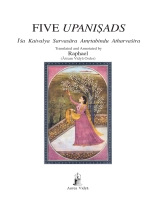The Upaniṣads are an integral part of Vedas, they represent a branch of the primordial Tradition and constitute the essence of Vedanta itself. The expression Vedanta (end of the Vedas) should be understood in the double meaning of ‘conclusion’, as the Upaniṣads are the last part of the Vedic texts, and of ‘purpose, ‘ because what is being taught is the ultimate goal of Traditional Knowledge.
The central theme of the Upanisads is the quest for the Ultimate Reality, they therefore represent Metaphysics in its real sense. This type of research is not an end to itself, for the Upaniṣads represent ways of contact and tools of realization; to this end they indicate a concise and complete sequence that concedes little or nothing to the analytical mind.
The five Upanisads presented in this text – Isa, Kaivalya, Sarvasāra, Amrtabindu, and Atharvasira – are commented extensively by Raphael. In his commentary, Raphael frames and broadens all the various points in the context of the traditional Advaita (Non-duality) teaching, and thus provides the western mind with the key to the comprehension of their symbolic, figurative, and analogical language.
قائمة المحتويات
Notes to the Text
Foreword
Isa Upanisad
Kaivalya Upaniṣads
Sarvasara Upanisad
Amrtabindu Upanisad
Atharvasira Upanisad
Sanskrit Text
Appendix – Structure of the Sruti and of the Smrti
Glossary
Raphael: Unity of Tradition












